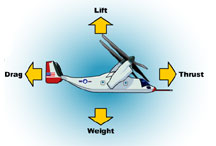Aerodynamics for Beginners
By Ricardo Peralta
What is Aerodynamics?
Have you ever wondered how enormous objects, like commercial planes, are able to fly? It’s because of the rules of aerodynamics. Aerodynamics is the way an object moves through the air. Those objects could range, from a home run ball flying through the air at Yankee Stadium, to a person skydiving from a plane thousands of feet high, to even a paper airplane.
The Four Forces of Flight
The four forces of flight are weight, lift, thrust, and drag. Weight is the force caused by the gravitational attraction of the earth. Lift is the force that directly opposes weight and holds an object, like an airplane, in the air. Thrust is the force applied on a object to move something forward, which is commonly produced by an engine. Drag is the force that pulls back on something trying to move. As shown in Figure 1, these four forces all come together to determine how an object moves through the air.

Gliders
Gliders are unique. A glider is an aircraft that has no engine, which means no thrust. So, as demonstrated by Figure 2, there are only three remaining forces that act on a glider in flight: weight, lift, and drag. One of the most commonly known glider aircraft is a paper airplane. Paper airplanes are a great way for beginners to grasp a better understanding of aerodynamics and see the forces of flight.

Paper Airplanes
Most people know how to make paper airplanes, but how do they work? Paper airplanes are able to fly without engines, because they use the forces of flight to their advantage. A paper airplane in flight, like a glider, only uses weight, lift, and drag forces. However, to make a paper airplane fly you need to throw it; you need an initial thrust. The other force that helps a paper airplane fly is lift. The lift of a paper airplane happens when the air pushing up against the bottom of the wings is stronger than the air that is pushing down above the plane (Scholastic). Lift is the force that makes it possible for the paper airplane to be in the air.
Why Paper?
People make paper airplanes out of paper as opposed to metal because it helps the plane overcome the force of gravity. By minimizing the weight you minimize the force that gravity has on the paper airplane.
Why not this Paper?
While reading this article you probably already realized the light gray lines and small numbers throughout both sides of this paper. These lines and numbers are meant to help you construct your own aerodynamic paper airplane. Follow the instructions on the top right of this side of the page to make the PA-2 model paper airplane; a design brought to you by NASA’s Glenn Research Center.
References:
Nasa Knows! (2017, March 1). What is Aerodynamics? Retrieved from https://www.nasa.gov
Paper Airplanes. Retrieved from https://www.grc.nasa.gov
Three Forces on a Glider. Retrieved from https://www.grc.nasa.gov
What Makes Paper Airplanes Fly? Retrieved from https://www.scholastic.com

